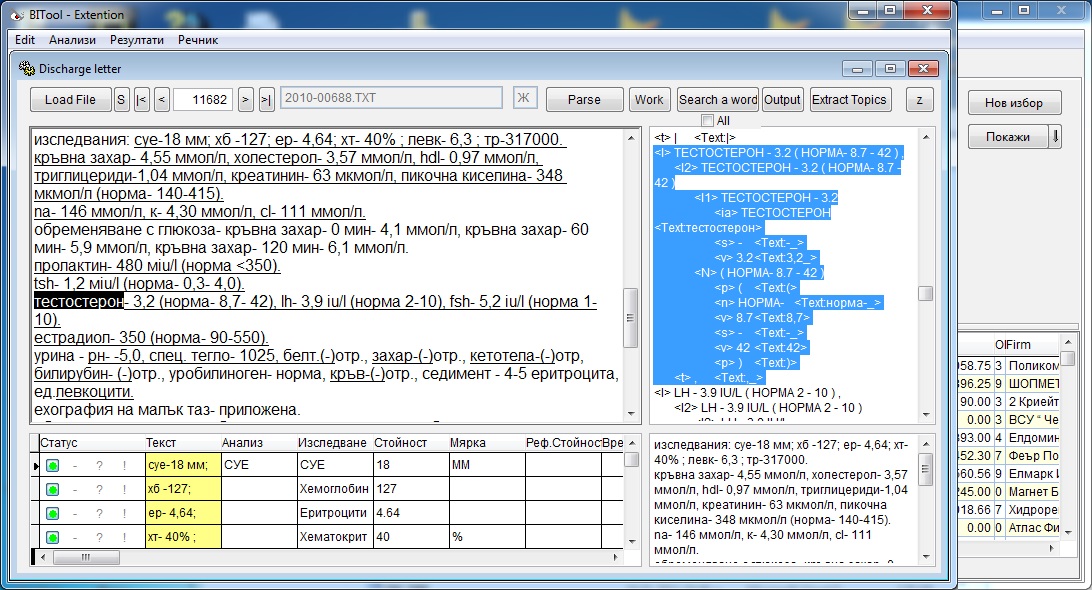BITool has typical Business Intelligence functionality: it supports the data warehousing processes ETL (Extract, Transform, Load) to integrate data from multiple sources; enables MDM (Master Data Management) as a methodology that identifies the most critical information in the enterprise and provides OLAP (online analytical processing) of multidimensional data cubes. Most data analytics tools have this functionality but the analysis of unstructured texts is beyond the scope of the field. In principle the Business Intelligence software is oriented to the needs of large organisations that generate massive volumes of structured information.
Initially data can be collected from various sources like databases or text files; from end user’s perspective data is stored in a large table viewed as a universal relation. The user can analyse data by grouping them according to some attributes that are considered as dimensions and definitions of aggregating functions over some of the remaining attributes viewed as types of facts. The visualisation is implemented in two modes: (i) exploration of tree-like structures of grouping attributes and filtering data according to the particular hierarchical node

or (ii) exploration of multi-dimensional data i.e. hyperplanes in the n-dimensional cube defined by the grouping attributes. The navigation is implemented by click and drag-drop manipulations of graphical objects. By automatic grouping (classification) of selected attributes the user can get a visual idea about the classes of objects constituting the specified dataset. If the table columns correspond to characteristics then the user can select particular columns and split the dataset into groups of objects with similar features. If temporal dimension is included the user can track changes of object characteristics over time by animation. BITool enables the discovery of similar situations over time when a search pattern is specified for a particular period.

The selection of dimensions is dynamic, i.e. the user can start some exploration by choice of certain attributes and later deepen the specification depending on the shown results without necessity to construct the n-dimensional cube once again. The intermediate results can be stored and kept for further explorations by other users.
With BITool you can:
- Generalise structured data
- Update, include or exclude attributes and dimensions
- Define new dimensions
- View graphical representations of proportions among values
- Track temporal changes of varying attributes
- Always consider the initial data from where each fact is elicited
- Use an information system without predefined searching criteria, with excellent visualisation facilities
- Export the extracted data in a variety of formats
- Store and disseminate the generalised data views so everyone can choose and consider the dimension she is interested in
- Speed up and improve the decision making process
BITool works on structured information but big data collections often contain free text fields that can be further analysed in order to identify essential facts which are vital for data exploration and the revealing of hidden interdependencies and associations. Having in mind the specific Bulgarian environment where big data only emerge and most information is stored as free text, we designed a simple but efficient strategy how to adopt the approach to the needs of Bulgarian public organisations that produce archives and large data repositories. Apparently some extraction and structuring functionality was needed and we implemented it by two text analysis tools: automatic identification of named entities in free text as well as automatic extraction of numeric values of preselected parameters from text descriptions.

Analysis of addresses: recognition of cities, villages, municipalities, streets

Recognition of organisations’ names presented with some variety

Analysis of the phrase ‘testosterone – 3,2 (norm- 8,7- 42)’ in a patient record
Further plans about BITool development concern deepening its capacity to analyse texts in public open data by automatic recognition of nomenclature and catalog entities.Further plans about BITool development concern deepening its capacity to analyse texts in public open data by automatic recognition of nomenclature and catalog entities.
